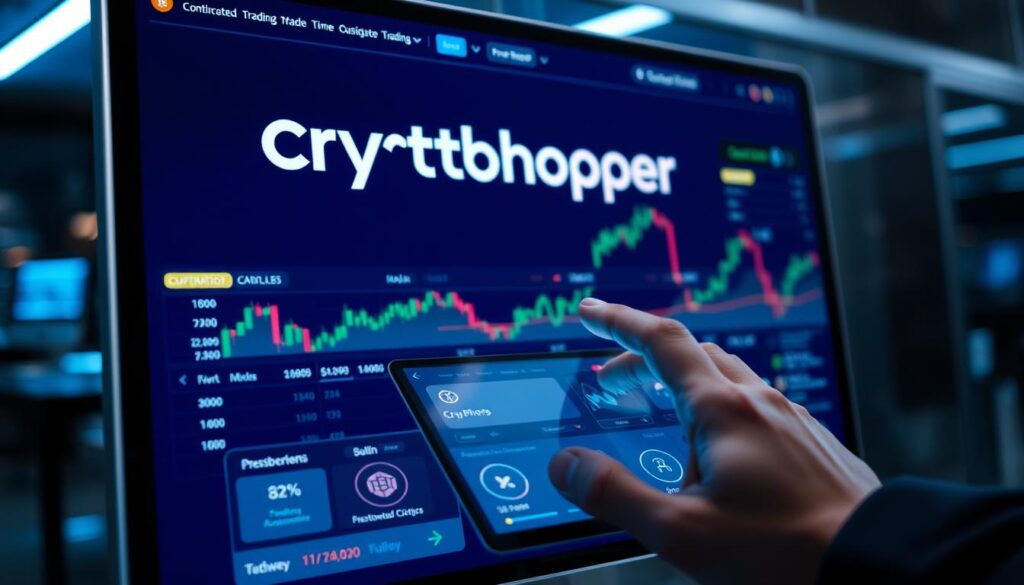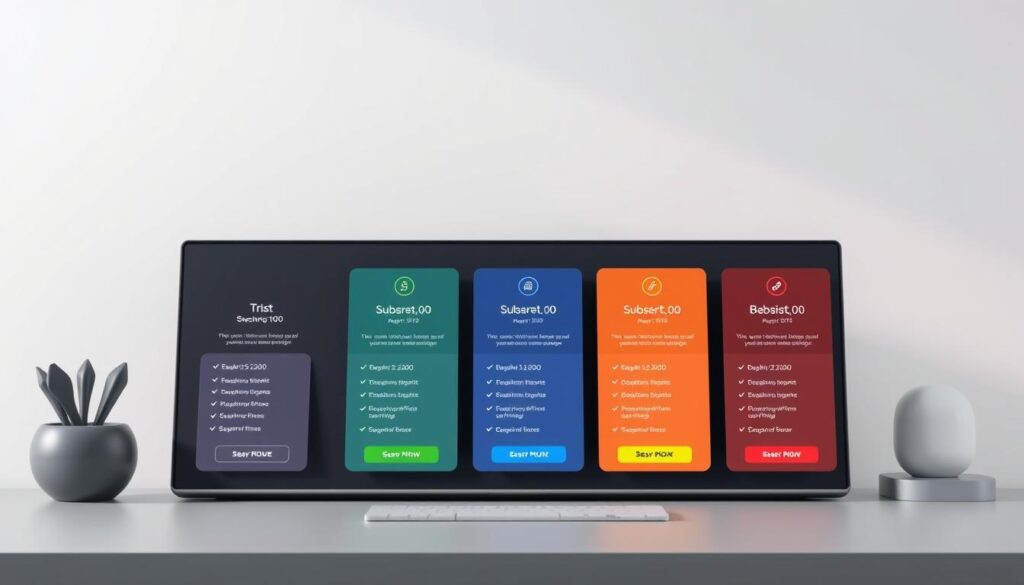Now Reading: AI Crypto Trading Bot Automation: Revolutionizing Trading
- 01
AI Crypto Trading Bot Automation: Revolutionizing Trading
AI Crypto Trading Bot Automation: Revolutionizing Trading

The digital finance landscape is changing fast. New technology is reshaping how people interact with markets. This shift brings powerful tools to investors of all experience levels.
These advanced systems use complex algorithms to make decisions. They operate without emotional bias, which is a common pitfall for people. This allows for continuous market monitoring, day and night.
In today’s fast-paced environment, speed is critical. Opportunities can vanish in moments. Automated systems can react instantly, a task difficult for any individual to maintain consistently.
The main benefit is continuous operation. A sophisticated trading bot executes trades based on pre-set rules. This frees up time for strategy and analysis instead of constant screen watching.
This technology makes advanced strategies accessible. What was once for large institutions is now available to everyone. It represents a significant step forward in the evolution of digital asset management.
Key Takeaways
- New technology is transforming market participation by removing emotional decision-making.
- Advanced algorithms enable 24/7 market monitoring and instant reaction times.
- Automation is essential for capturing opportunities in fast-moving digital asset markets.
- These systems free up traders to focus on strategy development and risk management.
- This innovation democratizes access to sophisticated investment approaches.
- The technology represents an evolution from manual to systematic, data-driven methods.
Introduction to the Future of Automated Crypto Trading
The integration of sophisticated technology into digital asset markets represents a fundamental shift in how participants engage with financial opportunities. This evolution moves beyond basic tools to create intelligent systems that enhance decision-making processes.
Overview of AI Integration in Crypto Trading
Financial platforms have transformed from simple order placement interfaces to complex analytical engines. These systems leverage computational power to process market information continuously. They identify patterns and opportunities that might escape human observation.
Modern systems analyze vast data streams in real-time. This capability allows for rapid adaptation to changing market conditions. The technology provides significant advantages in volatile environments.
Why Automation Appeals to Modern Traders
Many investors seek solutions that remove emotional interference from their decisions. Automated systems operate without the fear or greed that often affects human judgment. This creates more disciplined execution of strategies.
The ability to test approaches using historical data represents another major benefit. Participants can validate methods before committing capital. This backtesting process significantly reduces risk and builds confidence.
| Feature | Manual Approach | Automated System |
|---|---|---|
| Market Monitoring | Limited by human attention | Continuous 24/7 coverage |
| Emotion Control | Subject to psychological bias | Consistent rule-based execution |
| Strategy Testing | Trial and error with real funds | Historical validation before use |
| Operation Hours | Restricted by sleep patterns | Never sleeps, global coverage |
These technological advances make sophisticated methods accessible to beginners. What once required extensive experience now becomes available through intelligent platforms. The landscape continues to evolve toward greater accessibility and efficiency.
How AI is Revolutionizing Cryptocurrency Trading
Pattern recognition capabilities have transformed investment approaches. Modern systems identify subtle market patterns that escape human observation. This represents a significant advancement in financial technology.
Advances in Machine Learning and Algorithmic Trading
Machine learning algorithms continuously improve their predictive abilities. They analyze historical price movements and adapt to new data. This creates increasingly accurate market analysis over time.
The evolution from basic rules to intelligent systems represents a major leap. Today’s algorithms adjust strategies based on volatility and emerging trends. They require no manual reprogramming for these adaptations.
Neural networks process multiple data sources simultaneously. They evaluate price action, volume metrics, and social sentiment. This comprehensive analysis provides deeper market insights.
| Feature Type | Traditional Method | Modern Approach |
|---|---|---|
| Pattern Recognition | Manual chart analysis | Automated pattern detection |
| Strategy Adaptation | Fixed rule sets | Dynamic learning systems |
| Data Processing | Limited metrics | Multiple data streams |
| Execution Speed | Human reaction time | Instantaneous responses |
These systems execute complex strategies across different exchanges. They optimize for timing and liquidity factors. This multi-platform capability represents significant efficiency gains.
Real-world applications include arbitrage and trend-following methods. The technology makes sophisticated approaches accessible to various participants. This revolutionizing cryptocurrency trading creates both opportunities and new considerations for market engagement.
Understanding AI Crypto Trading Bot Automation
Digital asset management has evolved to include intelligent systems that operate independently. These platforms connect to exchanges using secure API connections. This allows real-time data processing and order execution.
The core components include market data analysis engines and decision-making algorithms. Systems receive price information and volume metrics continuously. They then execute buy/sell orders based on programmed instructions.
There’s a significant difference between basic algorithmic tools and advanced learning systems. Traditional programs follow fixed rules without adaptation. Modern solutions can adjust their approaches based on market feedback and performance data.
Users configure these systems with specific parameters and risk tolerance levels. The technology then operates within these guidelines autonomously. Regular monitoring of system performance remains essential for optimal results.
Various methods can be automated through these platforms:
- Simple dollar-cost averaging approaches
- Complex multi-indicator analysis systems
- Dynamic position sizing based on market conditions
- Multi-exchange arbitrage opportunities
A common misconception suggests these tools require no human oversight. While they execute consistently without emotional interference, proper configuration is crucial. Regular strategy refinement maintains effectiveness over time.
Realistic expectations include systematic execution benefits and ongoing adjustment needs. The technology provides disciplined implementation of investment approaches. However, market changes sometimes require manual intervention and strategy updates.
Top Automated Trading Bots for Cryptocurrency
The market for automated execution systems in digital currencies features several well-established platforms with distinct advantages. These solutions have gained recognition for their reliability and comprehensive feature sets.
Market Leaders and Innovative Platforms
Several prominent platforms stand out in the digital asset space. These include 3Commas, Cryptohopper, Coinrule, Shrimpy, Bitsgap, TradeSanta, HaasOnline, and Pionex.
This overview presents informational insights rather than a definitive ranking. Different tools serve various needs and preferences effectively.
Selection criteria focus on community reputation and supported strategies. Platforms offering grid methods, arbitrage, and dollar-cost averaging receive particular attention. Exchange integration capabilities also factor significantly.
Innovative approaches distinguish these market leaders. Some emphasize user-friendly interfaces while others offer advanced customization options. Each addresses common challenges uniquely.
| Platform | Key Strength | Strategy Support | Exchange Connections |
|---|---|---|---|
| 3Commas | Comprehensive toolset | Grid, DCA, Options | 20+ major exchanges |
| Cryptohopper | Cloud-based operation | Template strategies | 15+ supported platforms |
| Coinrule | Beginner-friendly interface | Rule-based automation | 10+ exchange options |
| Pionex | Built-in exchange features | Grid trading focus | Native platform |
Evaluation should consider individual goals and technical comfort. The right choice depends on specific market interests and risk tolerance levels.
Personal alignment with platform features matters more than popularity alone. Understanding how tools match objectives leads to better outcomes.
In-Depth Product Rundown: 3Commas and Its Features
Among the leading platforms in digital asset execution, 3Commas has established itself through comprehensive feature integration. The system serves a substantial community with impressive operational statistics across registered participants and connected exchange accounts.
User Experience and Interface Highlights
The platform’s design prioritizes accessibility without sacrificing advanced capabilities. New participants benefit from guided tutorials and pre-built strategy templates.
Seasoned market participants appreciate the sophisticated SmartTrade terminal. This feature enables complex order types and multi-exchange performance tracking.
Backtesting, Strategies, and Secure Practices
Historical analysis capabilities allow testing approaches against one year of minute-level data. This granular backtesting helps refine methods before live implementation.
The system supports diverse approaches including dollar-cost averaging and grid methodologies. Custom strategy integration through TradingView provides additional flexibility.
Security measures include API connections that prevent fund withdrawal access. The platform maintains regulatory compliance while proactively addressing emerging threats.
3Commas serves multiple user segments through tailored functionality. Asset managers benefit from bulk account operations and automated reporting.
Subscription plans start at $49 monthly for the Pro tier. The Expert plan at $79 unlocks additional features and fewer operational restrictions.
Exploring Cryptohopper and Other Noteworthy Bots
The evolution of trading platforms has introduced server-based systems that operate independently of personal computers. These solutions provide continuous market access without hardware limitations.
Cloud-Based Automation and Social Trading
Cryptohopper stands out with its cloud architecture. Users don’t need to keep computers running for continuous operation. This approach ensures uninterrupted market monitoring.

The platform offers comprehensive strategy design tools. Users can backtest approaches and access a marketplace for proven methods. Social features allow following successful traders’ moves.
Cryptohopper connects to 16 major exchanges including Binance and KuCoin. Pricing starts with a free Pioneer plan and scales to $107.50 monthly for the Hero tier.
| Platform | Primary Focus | Key Feature | Starting Price |
|---|---|---|---|
| Cryptohopper | Cloud-based execution | Strategy marketplace | Free |
| Shrimpy | Portfolio rebalancing | Automated allocation | Free |
| Coinrule | Rule-based systems | 250+ custom rules | Free |
| Pionex | Built-in exchange | 16 free bots | Free + 0.05% fee |
Other notable platforms serve different needs. Shrimpy specializes in portfolio management across multiple exchanges. Coinrule emphasizes customizable rule-based approaches.
Pionex operates as its own exchange with free bot access. TradeSanta offers simplicity while Bitsgap provides advanced order types. HaasOnline caters to developers seeking deep customization.
Each solution addresses specific market challenges differently. Exchange compatibility remains crucial when selecting appropriate tools.
Evaluating Trading Strategies and Backtesting Capabilities
Validating financial methods through systematic testing provides confidence in their potential effectiveness when deployed with real capital. This evaluation process helps identify approaches that align with specific market conditions and investment objectives.
Grid Trading, Arbitrage, and Dollar-Cost Averaging
Grid approaches profit from price fluctuations by placing orders at regular intervals. This method creates a systematic framework for capturing gains during market oscillations.
Arbitrage strategies exploit price differences across various platforms. Successful implementation requires rapid execution and careful consideration of transfer times between exchanges.
Dollar-cost averaging involves consistent investments regardless of current prices. This approach reduces timing risk and emotional decision-making over extended periods.
The Importance of Historical Data Analysis
Backtesting allows examination of how different strategies would have performed using past market information. This process reveals potential weaknesses and optimal settings before risking actual funds.
Effective analysis requires comprehensive historical data spanning various market conditions. Realistic factors like fees and execution delays must be included for accurate results.
Interpreting backtesting metrics helps determine whether an approach demonstrates genuine robustness. Proper validation builds confidence in the chosen methodology’s potential success.
Security, Risk Management, and Compliance in Trading Bots
When selecting execution platforms, security considerations should take priority over all other features. Protecting digital assets requires robust protocols that prevent unauthorized access and financial loss.
Reputable systems implement multiple layers of protection. These measures work together to create a secure environment for automated operations.
Secure API Connections and Two-Factor Authentication
Advanced platforms use API connections with restricted permissions. They can execute trades but cannot withdraw funds from exchange accounts.
Two-factor authentication adds critical protection. This requires secondary verification beyond passwords, significantly reducing unauthorized access risk.
| Security Feature | Basic Protection | Advanced Security | Enterprise Grade |
|---|---|---|---|
| API Permissions | Trade-only access | No withdrawal capability | Multi-signature approval |
| Authentication | Password required | 2FA enabled | Biometric verification |
| Data Encryption | Standard SSL | End-to-end encryption | Military-grade protocols |
| Risk Controls | Basic stop-loss | Multiple parameters | Real-time monitoring |

Effective risk management includes stop-loss settings and position size limits. These parameters protect against significant losses during volatile market conditions.
Users should verify platform compliance with regulations. Transparent providers maintain proper licensing and implement know-your-customer procedures where required.
Regular security audits and community reviews provide valuable insights. Checking a platform’s track record helps assess its reliability and security posture.
Security remains a shared responsibility between platform providers and users. Individuals must practice good digital hygiene while relying on robust system protections.
User Experience, Customization Options, and Support
The quality of a platform’s user experience often determines long-term success for market participants. A well-designed interface makes complex systems accessible to everyone.
New users benefit from intuitive navigation and clear visualizations. These features reduce setup errors and build confidence quickly.
Intuitive Platforms and Detailed Guides for Newbies
Leading platforms provide comprehensive educational resources. Beginners find strategy templates and video tutorials particularly helpful.
Advanced users appreciate deep customization tools. They can fine-tune parameters and implement sophisticated risk management rules.
| Feature Type | Beginner Focus | Advanced Options |
|---|---|---|
| Interface Design | Guided setup wizards | Custom dashboard layouts |
| Strategy Tools | Pre-configured templates | Indicator customization |
| Support Resources | Step-by-step guides | Technical documentation |
| Risk Controls | Basic stop-loss settings | Multi-parameter rules |
Reliable customer support remains essential for all skill levels. Quality platforms offer multiple contact methods including live chat and community forums.
These resources help users resolve issues quickly. They also provide ongoing education as participants develop their skills.
Pricing Plans, Subscriptions, and Overall Value
The cost-benefit analysis of subscription services plays a crucial role in determining which platform best suits individual trading needs. Different pricing tiers offer varying levels of access to features and tools.
Comparative Pricing Models and Fee Structures
Platforms use diverse approaches to their subscription plans. Some charge monthly fees while others incorporate trading commissions. Understanding these models helps users budget effectively.
Entry-level plans typically range from free to $30 monthly. Mid-tier options cost between $50 and $80. Professional subscriptions often exceed $100 per month.
| Platform | Entry Plan | Mid-Tier | Professional |
|---|---|---|---|
| 3Commas | $49/month | $79/month | N/A |
| Cryptohopper | Free | $57.50/month | $107.50/month |
| Coinrule | Free | $59.99/month | $449.99/month |
| TradeSanta | $18/month | $32/month | $45/month |

Subscription Benefits for Advanced Traders
Higher-tier subscriptions unlock significant advantages for serious participants. These include unlimited strategy deployments and priority support access.
Advanced users gain sophisticated risk management tools. They also receive API access for custom integrations. Dedicated account management becomes available at premium levels.
Evaluating total costs beyond subscription fees remains essential. Consider exchange commissions and potential performance charges. The time savings from efficient execution often justify the investment.
Integration with Top Cryptocurrency Exchanges
Exchange connectivity serves as the foundation for successful automated market participation. The value of any execution system depends on its ability to connect with established financial venues. This integration determines market reach and operational efficiency.
Leading platforms offer connections to numerous financial exchanges worldwide. This broad access enables comprehensive market coverage and opportunity identification.
Supported Exchanges and Connectivity
Modern systems use secure API connections to interface with various trading venues. These interfaces allow real-time data access and order execution across multiple platforms.
Reputable services integrate with 15 to 25+ major exchanges including industry leaders. This extensive connectivity reduces dependency on single venues and enhances security.
Ensuring Liquidity and Competitive Trading Fees
Exchange selection directly impacts execution quality through liquidity factors. Deep order books and tight spreads improve trade performance significantly.
Fee structures vary considerably across different trading venues. These differences compound over time, especially for frequent execution strategies.
| Exchange Feature | Basic Level | Standard Level | Premium Level |
|---|---|---|---|
| Security Protocols | Basic encryption | Multi-factor authentication | Advanced monitoring systems |
| Trading Fees | 0.2% and above | 0.1%-0.2% range | Below 0.1% with volume |
| Liquidity Depth | Limited order books | Moderate depth | Deep liquidity pools |
| Geographic Access | Regional restrictions | Multiple regions | Global availability |
Choosing exchanges with strong reputations and competitive fees enhances overall results. Proper venue selection aligns with individual strategy requirements and risk tolerance.
Guidance: How to Choose the Right Trading Bot for Your Needs
Selecting the right execution platform requires careful consideration of personal objectives and technical features. This decision impacts your overall experience and results.
Defining Investment Goals and Risk Tolerance
Start by clarifying your financial targets. Are you seeking quick gains or long-term growth? Your timeframe determines which strategies work best.
Understanding your comfort with volatility is equally important. Conservative participants need different tools than aggressive ones. This self-assessment guides your platform selection.

Evaluating Features, User Reviews, and Market Performance
Examine the technical capabilities of each option. Check supported exchanges and available methods. Ensure they match your preferred approach.
Research community feedback thoroughly. Look for consistent patterns in user experiences. Real-world performance data often reveals more than marketing claims.
| Evaluation Factor | Basic Consideration | Advanced Check |
|---|---|---|
| Strategy Alignment | Matches initial goals | Adapts to changing conditions |
| User Feedback | Overall satisfaction | Long-term reliability reports |
| Security Measures | Basic encryption | Advanced protection features |
| Cost Structure | Upfront fees | Hidden charges analysis |
Remember that these tools require ongoing attention. Regular monitoring and adjustments ensure they continue meeting your needs effectively.
Conclusion
The journey through automated financial tools reveals a landscape where technology serves as a powerful ally rather than a complete replacement for human judgment. These systems have transformed market participation by enabling continuous operation and removing emotional interference.
Success ultimately depends on selecting the right tools for your specific circumstances and properly configuring your approach. Regular oversight and strategy refinement remain essential for optimal results over time.
We encourage readers to begin exploring through free trials or small-scale testing. Hands-on experience provides the best understanding of how these tools function in real market conditions.
Remember that while technology enhances efficiency, it works best when combined with solid fundamentals and realistic expectations. All market participation involves risk that no system can completely eliminate.
FAQ
How does an automated system execute strategies in volatile markets?
These systems use pre-set plans to react to real-time market conditions. They analyze price movements and execute trades based on your chosen strategy, helping to manage risk and capitalize on opportunities 24/7 without emotional interference.
What is backtesting and why is it important?
Backtesting involves running your plan against historical data to see how it would have performed. This process is vital for refining your approach, identifying potential weaknesses, and increasing confidence before using real funds.
Are these platforms safe to use with my exchange account?
A> Reputable platforms prioritize security. They use secure API connections that grant trade execution access without withdrawal permissions. Always enable two-factor authentication and choose services with a strong track record for user safety.
Can I practice with a system before committing real capital?
Yes, many services offer paper trading features. This allows you to test your strategies and get familiar with the interface using simulated funds, which is an excellent way to build experience without financial risk.
What kind of ongoing support can users expect?
Top providers offer comprehensive support, including detailed guides, responsive customer service teams, and active community forums. This ensures you can get help with setup, strategy optimization, and troubleshooting.
How do pricing plans typically work for these tools?
Most operate on a subscription model with tiered plans. These tiers offer varying levels of access to features like the number of active strategies, exchange connections, and advanced analysis tools. It’s important to choose a plan that matches your activity level.
Which major exchanges do these automation tools support?
Leading platforms typically integrate with major exchanges like Binance, Coinbase Pro, and Kraken. This connectivity ensures liquidity and allows the system to operate across different markets, providing more opportunities for your plans.














